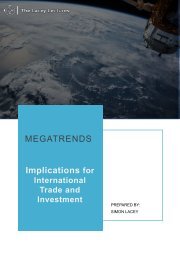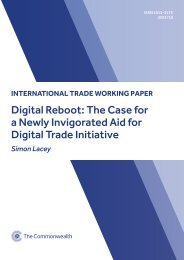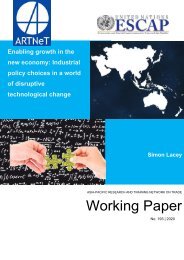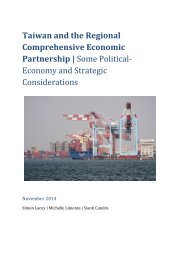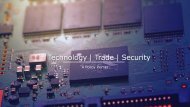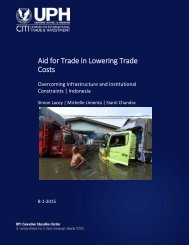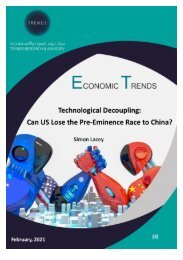Cross Border Data Flows: The impact of data localisation on IoT
This industry report seeks to shed new light on the costs of imposing data localization requirements or other restrictions on cross-border data flows with respect to the important economic growth likely to result from the uptake and adoption of IoT in manufacturing, agriculture and other important sectors of the economy. It chooses 3 large emerging markets in order to showcase its model, namely Brazil, Indonesia and South Africa.
This industry report seeks to shed new light on the costs of imposing data localization requirements or other restrictions on cross-border data flows with respect to the important economic growth likely to result from the uptake and adoption of IoT in manufacturing, agriculture and other important sectors of the economy. It chooses 3 large emerging markets in order to showcase its model, namely Brazil, Indonesia and South Africa.
Create successful ePaper yourself
Turn your PDF publications into a flip-book with our unique Google optimized e-Paper software.
CROSS-BORDER DATA FLOWS: THE IMPACT OF DATA LOCALISATION ON IOT<br />
Technical Report<br />
Anticipated gains from the Internet <str<strong>on</strong>g>of</str<strong>on</strong>g> Things (<strong>IoT</strong>) exceeds most other technologies.<br />
Digitalisati<strong>on</strong> is, without doubt, <strong>on</strong>e <str<strong>on</strong>g>of</str<strong>on</strong>g> the biggest<br />
innovati<strong>on</strong>s to ever <str<strong>on</strong>g>impact</str<strong>on</strong>g> the global ec<strong>on</strong>omy. As it<br />
progresses, we will see the emergence <str<strong>on</strong>g>of</str<strong>on</strong>g> the Internet<str<strong>on</strong>g>of</str<strong>on</strong>g>-Things<br />
(<strong>IoT</strong>), <str<strong>on</strong>g>of</str<strong>on</strong>g> devices, sensors, infrastructure and<br />
automated systems communicating with each other.<br />
<str<strong>on</strong>g>The</str<strong>on</strong>g> technology is at the nexus <str<strong>on</strong>g>of</str<strong>on</strong>g> wireless c<strong>on</strong>nectivity,<br />
automati<strong>on</strong> and <str<strong>on</strong>g>data</str<strong>on</strong>g>-driven applicati<strong>on</strong>s. In particular,<br />
its industrial use is already having a significant <str<strong>on</strong>g>impact</str<strong>on</strong>g><br />
<strong>on</strong> how businesses operate. By deploying c<strong>on</strong>nected<br />
devices across the organisati<strong>on</strong>, businesses can make<br />
improvements, enabling ‘smart’ producti<strong>on</strong> methods,<br />
and c<strong>on</strong>cepts such as ‘Industry 4.0’, ‘Society 5.0’ and<br />
‘digital manufacturing’.<br />
Ec<strong>on</strong>omically speaking, <strong>IoT</strong> will bring about cost<br />
reducti<strong>on</strong>s through efficiency gains and increased<br />
producti<strong>on</strong> flexibility. In additi<strong>on</strong>, it will allow for shorter<br />
feedback loops between different producti<strong>on</strong> stages –<br />
from design, prototyping, mass-producti<strong>on</strong>, testing and<br />
go-to-market.<br />
Overall, <strong>IoT</strong> leads to increased productivity, 5 enhanced<br />
energy or cost efficiencies and lower envir<strong>on</strong>mental<br />
<str<strong>on</strong>g>impact</str<strong>on</strong>g>. Given the many benefits, the number <str<strong>on</strong>g>of</str<strong>on</strong>g> <strong>IoT</strong><br />
c<strong>on</strong>necti<strong>on</strong>s is growing by almost 15% per year and<br />
is set to reach approximately 25 billi<strong>on</strong> c<strong>on</strong>necti<strong>on</strong>s<br />
by 2025. By then, the number <str<strong>on</strong>g>of</str<strong>on</strong>g> <strong>IoT</strong> (i.e. machine-tomachine)<br />
c<strong>on</strong>necti<strong>on</strong>s will outnumber pers<strong>on</strong>al devices<br />
(such as ph<strong>on</strong>es and computers) c<strong>on</strong>nected to wireless<br />
networks.<br />
<str<strong>on</strong>g>The</str<strong>on</strong>g> uptake <str<strong>on</strong>g>of</str<strong>on</strong>g> <strong>IoT</strong> is also intricately linked to the<br />
deployment <str<strong>on</strong>g>of</str<strong>on</strong>g> 5G. Of course, 5G (with speeds 200<br />
times faster than 4G) will enable mass c<strong>on</strong>sumer<br />
applicati<strong>on</strong>s such as instant streaming <str<strong>on</strong>g>of</str<strong>on</strong>g> HD c<strong>on</strong>tent.<br />
<str<strong>on</strong>g>The</str<strong>on</strong>g> ec<strong>on</strong>omic <str<strong>on</strong>g>impact</str<strong>on</strong>g> <str<strong>on</strong>g>of</str<strong>on</strong>g> pers<strong>on</strong>al applicati<strong>on</strong>s,<br />
however, is relatively modest compared to potential<br />
industrial use. <strong>IoT</strong> under 5G will benefit from 20<br />
times shorter latencies and 1,000 times better energy<br />
efficiencies. <strong>IoT</strong> running <strong>on</strong> 5G networks will seamlessly<br />
c<strong>on</strong>nect sensors <strong>on</strong> industrial equipment, vehicles<br />
and infrastructure, which in turn will enable the<br />
unprecedented real-time and large-scale collecti<strong>on</strong><br />
<str<strong>on</strong>g>of</str<strong>on</strong>g> <str<strong>on</strong>g>data</str<strong>on</strong>g>. This will enable big <str<strong>on</strong>g>data</str<strong>on</strong>g> analytics and<br />
artificial intelligence (AI) to provide feedback for the<br />
optimisati<strong>on</strong> <str<strong>on</strong>g>of</str<strong>on</strong>g> business processes, logistics or pricing<br />
in real-time.<br />
<strong>IoT</strong> has already become a horiz<strong>on</strong>tal technology<br />
<str<strong>on</strong>g>impact</str<strong>on</strong>g>ing numerous ec<strong>on</strong>omic sectors, including<br />
manufacturing, agriculture, mining, retail, transport,<br />
utilities, healthcare, entertainment and educati<strong>on</strong>.<br />
5. Supekar et al. A Framework for Quantifying Energy and Productivity Benefits <str<strong>on</strong>g>of</str<strong>on</strong>g> Smart Manufacturing Technologies, published in: ‘26th CIRP Life Cycle Engineering (LCE) C<strong>on</strong>ference’<br />
2019, at p. 699.<br />
8




